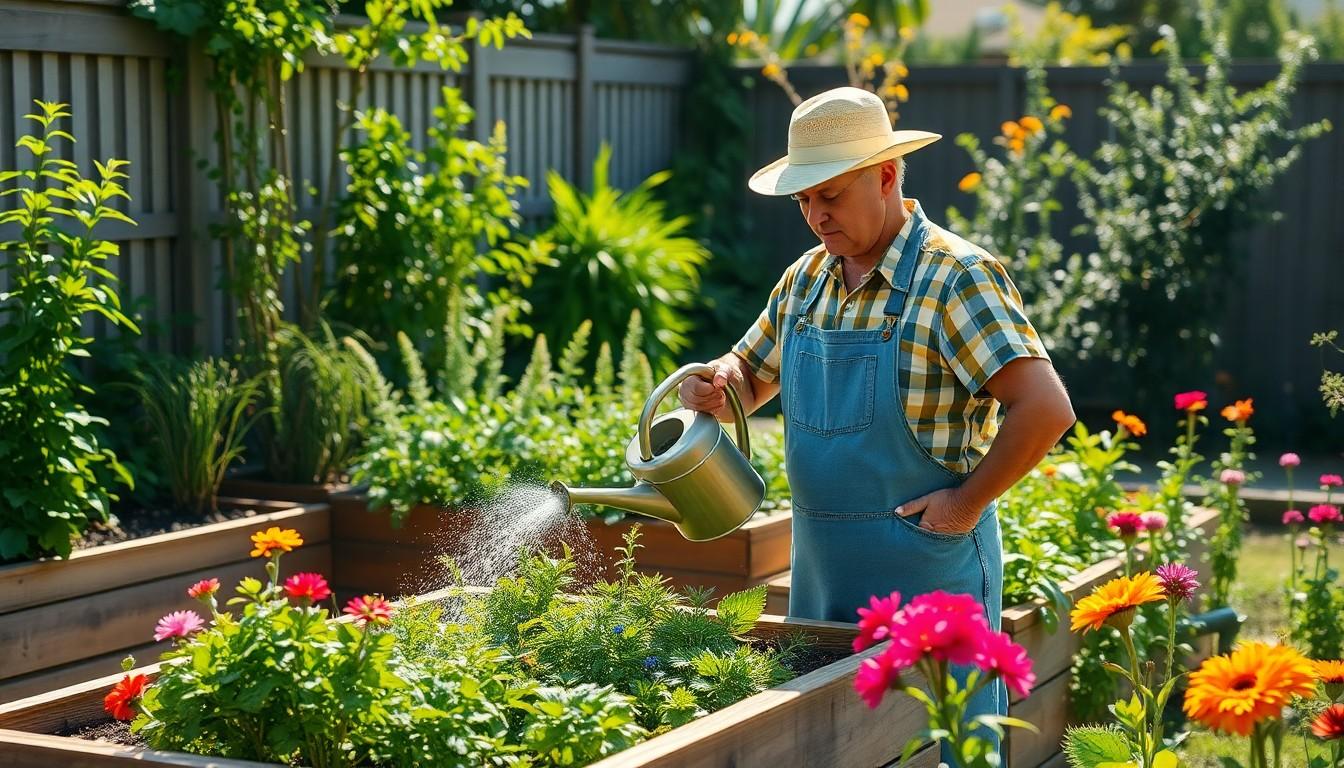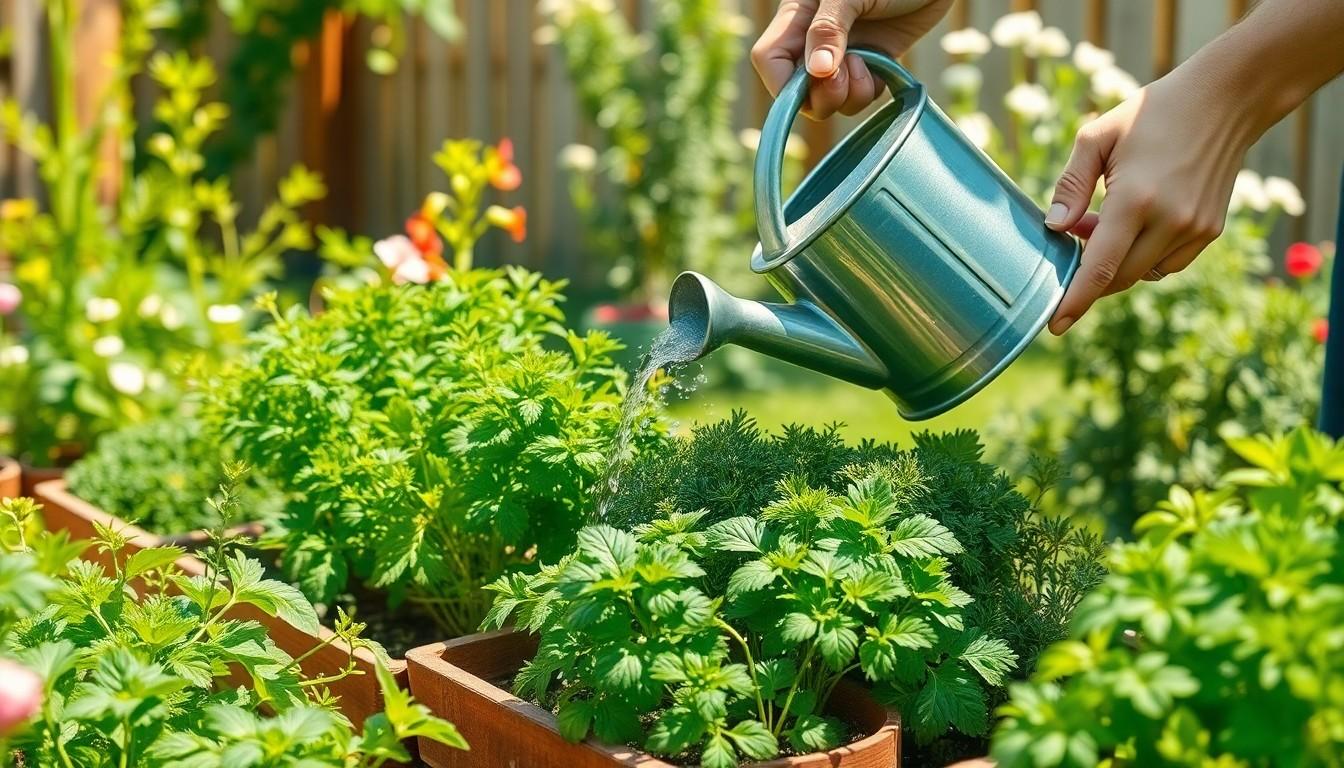Growing herbs can feel like a delightful culinary adventure, but without the right watering techniques, even the most promising basil could end up as a wilted memory. It’s not just about splashing water on the soil; it’s a delicate dance of moisture and timing. Whether you’re a seasoned green thumb or a novice plant parent, understanding how to keep those herbs hydrated is crucial for a thriving garden.
Herb Watering Guide
Successful herb cultivation depends on understanding specific watering needs. Each herb requires attention to moisture levels for optimal growth.
Different Types of Herbs
Herbs can be categorized into culinary, medicinal, and ornamental varieties. Culinary herbs, like basil and parsley, generally prefer consistent moisture. Medicinal herbs, such as echinacea and chamomile, may require less frequent watering. Ornamental herbs, including lavender, thrive on drier conditions. Each type varies in its water requirements, highlighting the importance of recognizing individual needs for healthy growth.
Factors Influencing Watering Requirements
Environmental factors significantly impact herb watering needs. Soil type plays a crucial role; sandy soils drain quickly while clay retains moisture. Temperature affects evaporation rates, so hotter weather demands more frequent watering. Humidity levels also influence moisture retention in the air and soil. Finally, the growth stage of herbs determines their water intake; young plants require more attention compared to mature ones. Adjusting watering practices according to these factors ensures optimal health for herbs.
Watering Techniques for Herbs

Effective watering techniques enhance the growth of herbs. Understanding various methods ensures optimal hydration tailored to specific herb types.
Drip Irrigation
Drip irrigation provides a consistent water supply directly to the herb roots. This technique minimizes evaporation and runoff, making it efficient for maintaining moisture. Many gardeners prefer drip systems for their ability to deliver targeted watering. They can adapt to various garden layouts, whether planting in rows or containers. Regular maintenance of the system ensures functionality, preventing clogging from debris or mineral buildup.
Hand Watering
Hand watering offers flexibility and precision when applying water to herbs. Gardeners can assess the soil moisture level easily and adjust based on the needs of different herb varieties. This method allows for personal connection with the plants, helping to identify early signs of stress. It’s essential to use a gentle flow to avoid disturbing the soil or damaging delicate roots. Timing plays a critical role, with morning watering reducing evaporation rates and promoting better absorption.
Self-Watering Systems
Self-watering systems provide a more automated solution for consistent moisture levels. These setups often include reservoirs that supply water gradually through a wicking action. Self-watering pots are especially useful for busy individuals or those with limited gardening experience. They help to prevent overwatering by allowing herbs to draw moisture as needed. Various designs are available, from simple container methods to complex setups involving timers and sensors. Having such systems ensures herbs receive adequate hydration, promoting healthy growth.
Best Practices for Herb Watering
Successful herb gardening depends on proper watering techniques, ensuring herbs thrive while maintaining sufficient moisture. Following best practices enhances hydration and overall plant health.
Timing and Frequency
Watering herbs requires a consistent schedule based on factors like climate and herb type. Morning hours often provide the best time for watering, as it allows moisture to absorb before heat affects evaporation. Experienced gardeners understand that young herbs may need daily watering in hot weather, while established ones generally require less frequent hydration. Checking soil moisture before watering helps determine if it’s the right time to water. Consider environmental conditions, as humidity and temperature can affect frequency. Adjusting the watering routine throughout the seasons promotes stronger herb growth.
Soil Moisture Management
Soil moisture management plays a crucial role in herb health. Checking moisture levels regularly helps prevent overwatering or underwatering. A simple method involves digging a finger 1 inch into the soil to assess moisture conditions. Moist soil indicates sufficient hydration, while dryness indicates a need for watering. Using well-draining soil mixes supports proper moisture retention without causing root rot. Mulching around herbs can also help maintain consistent moisture levels while reducing evaporation. Different herbs have varied moisture preferences; understanding these needs allows for effective watering practices tailored for each variety.
Common Mistakes in Herb Watering
Understanding common watering mistakes helps maintain a healthy herb garden. Overwatering and underwatering often lead to poor herb health.
Overwatering
Overwatering occurs when plants sit in waterlogged soil, which can cause root rot. It’s crucial for gardeners to recognize signs like yellowing leaves or wilting, as these indicate excessive moisture. Inspecting soil moisture can prevent this issue; ensuring it feels damp but not saturated is vital. Drip irrigation systems help avoid overwatering by delivering precise amounts directly to roots. Additionally, using well-draining soil mixes promotes better drainage and reduces the risk. Monitoring frequency based on climate and plant needs also aids in avoiding overwatering disasters.
Underwatering
Underwatering leads to stressed herbs, resulting in droopy leaves and diminished growth. Ensuring consistent soil moisture is essential for herb health. Check soil texture, as dry soil often indicates the need for immediate watering. Plants respond well to deep watering, which encourages deep root systems. Morning watering allows plants to absorb moisture before the heat of the day increases evaporation. It’s beneficial to adjust watering schedules by considering environmental factors like temperature and humidity. Regular checks on moisture levels will ensure plants receive adequate hydration for optimal growth.
Aiming for a Thriving Herb Garden
Mastering the art of watering herbs is essential for any gardener aiming for a thriving herb garden. By understanding the specific needs of culinary, medicinal, and ornamental herbs, gardeners can tailor their watering practices effectively.
Implementing the right techniques such as drip irrigation or hand watering can significantly enhance herb growth. Regular monitoring of soil moisture and environmental factors ensures that each plant receives the hydration it requires to flourish.
Avoiding common pitfalls like overwatering or underwatering will lead to healthier herbs and a more bountiful harvest. With the right knowledge and practices in place, anyone can cultivate a vibrant and productive herb garden.

